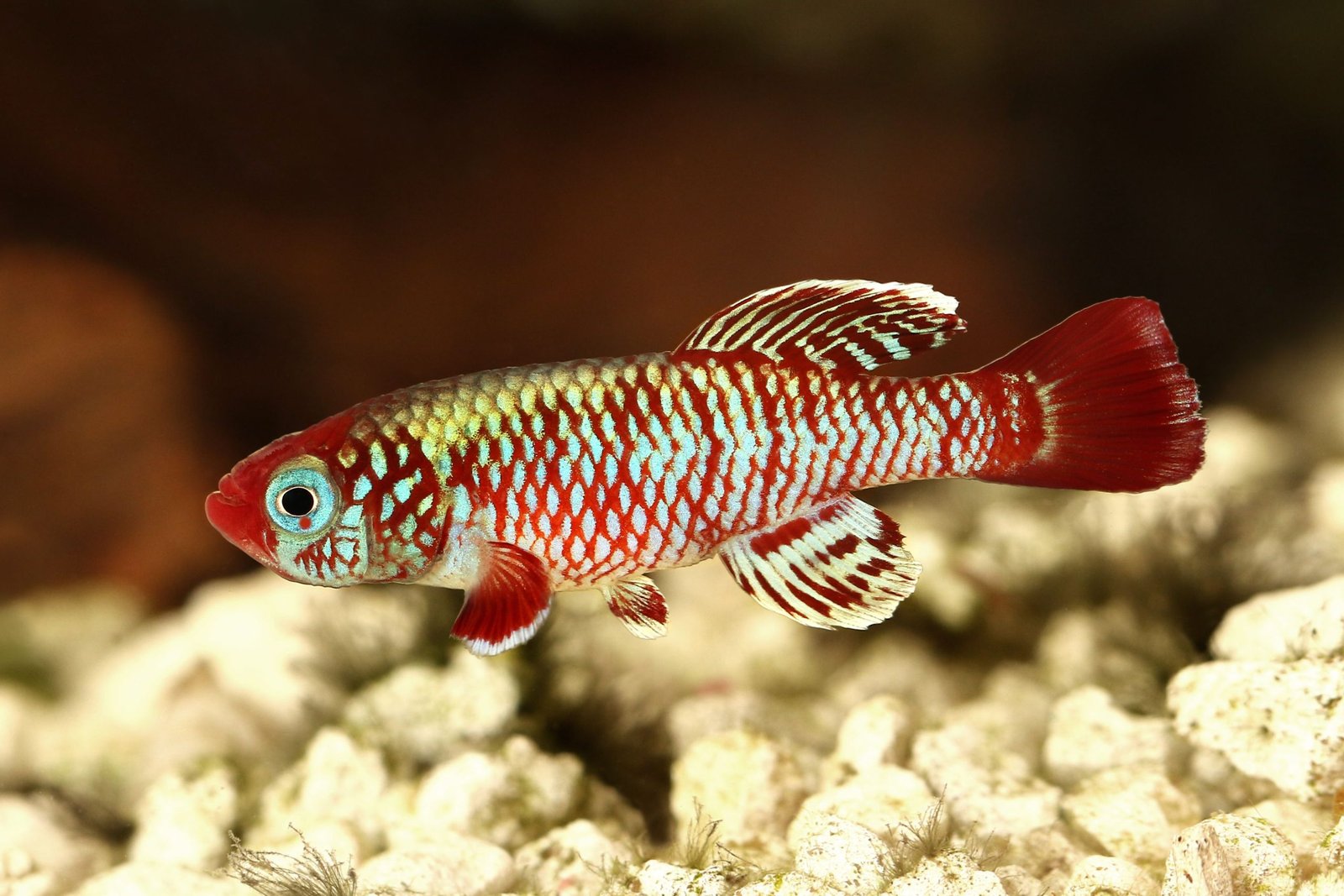Killifish are small fish that are a great choice for beginners. They are small, easy to care for, and have a varied diet.
With a maximum length of seven inches, killifish eat small crustaceans, mollusks, and worms. They breed in the summer, with males developing brighter coloration during breeding. Females lay eggs in still, shallow water and have been observed burying the eggs.
Keeping killifish ranges from easy to difficult, depending on the species, as they hatch, grow, reproduce, and die within a year, and their eggs go dormant until the next rainy season. Killifish can be fed live or frozen brine shrimp, daphnia, mosquito larvae, white worms, and some dry foods.

Credit: www.villagebooks.com
Introduction To Killifish
Killifish are a group of small fish that are known for their vibrant colors and fascinating behavior. These beautiful aquatic creatures have captured the attention of fish enthusiasts and hobbyists around the world. Whether you are a seasoned aquarist or a beginner looking to add some life to your aquarium, understanding the basics of killifish is essential. In this article, we will explore everything you need to know about killifish, from their characteristics and habitat to their interesting facts and care requirements.
What Are Killifish?
Killifish are a diverse group of small fish that belong to the family Cyprinodontidae. With over 1200 known species, these fish come in a wide range of shapes, sizes, and colors. They are particularly known for their vibrant and striking coloration, making them a popular choice for aquarium enthusiasts. Some common types of killifish include the Blue Gularis, Golden Wonder, and Aphyosemion.
Interesting Facts About Killifish
- Killifish can reach up to seven inches in length, depending on the species.
- These fish have a varied diet, consuming small crustaceans, mollusks, worms, and even some seeds in the wild.
- During breeding, male killifish develop even brighter and more vibrant colors to attract potential mates.
- Females lay their eggs in still, shallow water and have been observed burying the eggs to protect them from predators.
Habitat And Distribution
Killifish are found in various habitats across the world, ranging from freshwater streams and rivers to swamps and temporary pools. They are native to regions such as Africa, the Americas, Europe, and Asia. Some species of killifish are even capable of surviving in brackish water. These fish have adapted to their specific habitats, displaying a remarkable ability to withstand changing environmental conditions.
If you are thinking of keeping killifish as pets, it is important to recreate their natural habitat in your aquarium. Providing a suitable environment with appropriate water parameters and vegetation will ensure the well-being and happiness of your killifish.

Credit: www.walmart.com
Caring For Killifish
Killifish are beautiful and vibrant fish that make a great addition to any aquarium. While they may not be as well-known as some other fish species, if properly cared for, they can thrive and bring a unique charm to your tank. In this section, we will explore the key aspects of caring for killifish, including their diet, tank conditions, and breeding and reproduction.
What Do Killifish Eat?
When it comes to their diet, killifish are not picky eaters. In the wild, they feed on small crustaceans, flying and aquatic insects, and even some seeds. In captivity, it is important to provide them with a varied diet to ensure their nutritional needs are met.
For captive killifish, live or frozen foods work best. Some popular food options include:
- Brine shrimp
- Daphnia (a small crustacean)
- Mosquito larvae
- White worms
In addition to these live foods, you can also supplement their diet with some dry foods specifically designed for killifish. It is always a good idea to provide a mix of both live and dry foods to keep your killifish healthy and satisfied.
Tank Conditions For Killifish
Creating the right tank conditions for your killifish is crucial for their overall well-being. Here are the factors you need to consider:
| Water temperature: | Keep the water temperature between 70°F and 74°F (21°C to 23°C). |
|---|---|
| Water parameters: | Maintain a pH level between 6.0 and 7.5 and a water hardness of 5 to 15 dH. |
| Tank size: | Provide at least a 10-gallon tank for a small group of killifish. |
| Filtration: | Use a reliable filter that provides both mechanical and biological filtration. |
| Decorations: | Add some plants and hiding spots in the tank to mimic their natural habitat. |
| Water quality: | Regularly test the water parameters and perform regular water changes to maintain good water quality. |
Remember, killifish are jumpers, so always make sure the tank has a suitable lid to prevent any mishaps.
Breeding And Reproduction
When it comes to breeding and reproduction, killifish have some fascinating behaviors. They are known for their unique reproductive strategy, which involves laying eggs in still, shallow water.
Here are some key points to consider:
- During the breeding season, males develop brighter coloration and display courtship behavior to attract females.
- Once the female has laid her eggs, it is essential to remove them from the tank and incubate them separately.
- Killifish eggs have a dormant period and require specific conditions to hatch successfully.
- After the eggs hatch, the fry should be provided with small live foods to ensure healthy growth.
It is important to note that breeding and raising killifish fry can be a more advanced aspect of killifish care. If you are a beginner, it might be best to focus on the basics first and gain experience before attempting to breed them.
By understanding the specific diet requirements, tank conditions, and breeding behaviors of killifish, you can provide them with the care they need to thrive and enjoy their vibrant presence in your aquarium.
Tips For Keeping Killifish
Killifish are a group of small fish that are known for their vibrant colors and unique patterns. If you are considering keeping killifish as pets, there are a few important tips to keep in mind to ensure their health and happiness. In this section, we will discuss choosing suitable tank mates, beginner-friendly killifish species, and the challenges involved in keeping killifish.
Choosing Suitable Tank Mates
When it comes to keeping killifish, it is crucial to choose suitable tank mates that will coexist peacefully. Killifish can be territorial, so it is best to avoid aggressive species that may nip at their fins or display dominance. Some suitable tank mates for killifish include:
- Tetras
- Guppies
- Cory catfish
- Neon tetras
- Zebrafish
- Tiger barbs
By selecting compatible tank mates, you can create a harmonious aquarium environment for your killifish.
Beginner-friendly Killifish Species
If you are new to keeping killifish, it is recommended to start with beginner-friendly species. These species are small in size and relatively easy to care for, making them perfect for novice fishkeepers. Some beginner-friendly killifish species include:
- Least killifish
- Banded panchax
- Blue lyretail
- Striped panchax
- Fundulopanchax gardneri
- Epiplatys
These species require a varied diet and proper water conditions, but with the right care, they can thrive in a home aquarium.
Challenges In Keeping Killifish
While killifish can be rewarding pets, there are also some challenges involved in their care. One of the main challenges is their short lifespan. Killifish typically live for less than a year, with some species lasting even shorter periods. Their eggs are also unique, as they can go dormant until the next rainy season. Additionally, keeping killifish ranges from easy to difficult, depending on the species you choose.
To overcome these challenges, it is important to research the specific needs of the killifish species you intend to keep. This includes understanding their habitat, feeding requirements, and breeding habits. By providing the right conditions and care, you can create a thriving environment for your killifish.

Credit: www.walmart.com
Frequently Asked Questions Of Everything You Need To Know About Killifish
Are Killifish Good For Beginners?
Some species of killifish are good for beginners. They are small, easy to care for, but require a varied diet.
What Are Some Interesting Facts About Killifish?
Killifish can reach up to seven inches in length and feed on small crustaceans, mollusks, and worms. During breeding, males develop brighter coloration, and females bury their eggs in still, shallow water. Killifish are fascinating and can be a great choice for beginners, as they are small and relatively easy to care for.
Are Killifish Hard To Keep?
Killifish can be easy to care for, depending on the species. They have a short lifespan and their eggs can go dormant until the next rainy season. Some species are suitable for beginners, but they require a varied diet.
What Do Killifish Like To Eat?
Killifish enjoy a diet of small crustaceans, insects, seeds, and brine shrimp. They can also eat daphnia and mosquito larvae, both live or frozen. In captivity, they can be fed dry foods as well. Keep in mind that they need a varied diet for optimal health.
Conclusion
Killifish are fascinating creatures that can make a unique addition to any aquarium. With their vibrant colors and small size, they are a great choice for beginners looking to care for fish. While they may have specific dietary needs and require different levels of care depending on the species, killifish offer an enjoyable and rewarding experience for those willing to put in the effort.
So, if you’re considering adding killifish to your aquarium, make sure to do your research and provide them with the optimal conditions for their growth and well-being.


